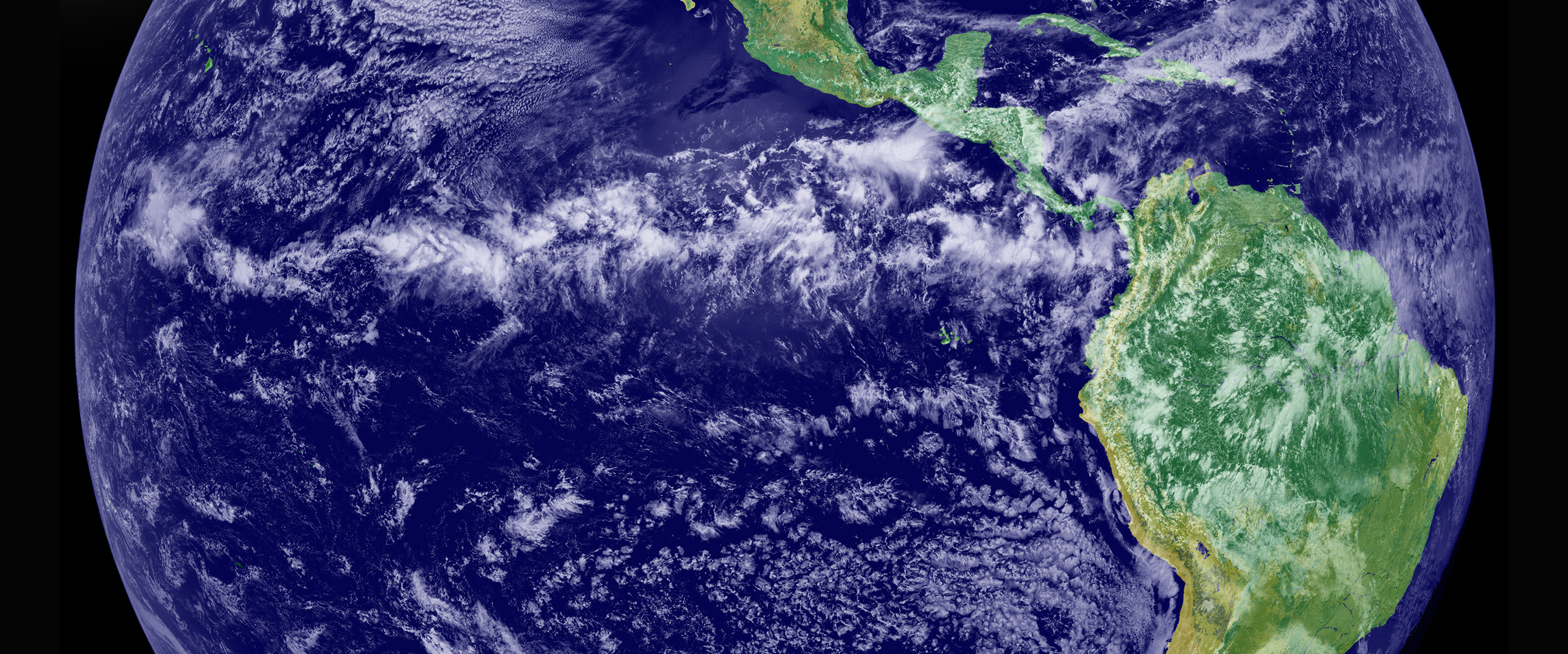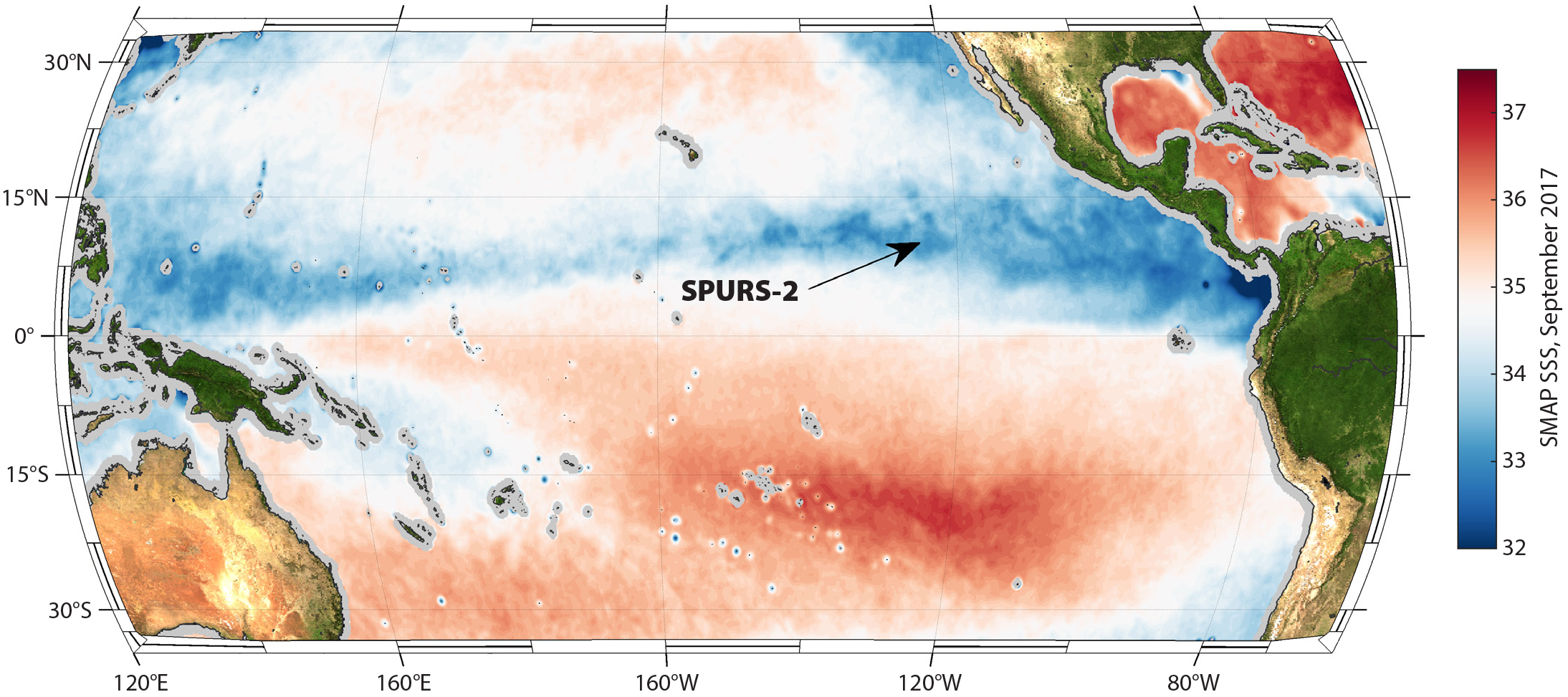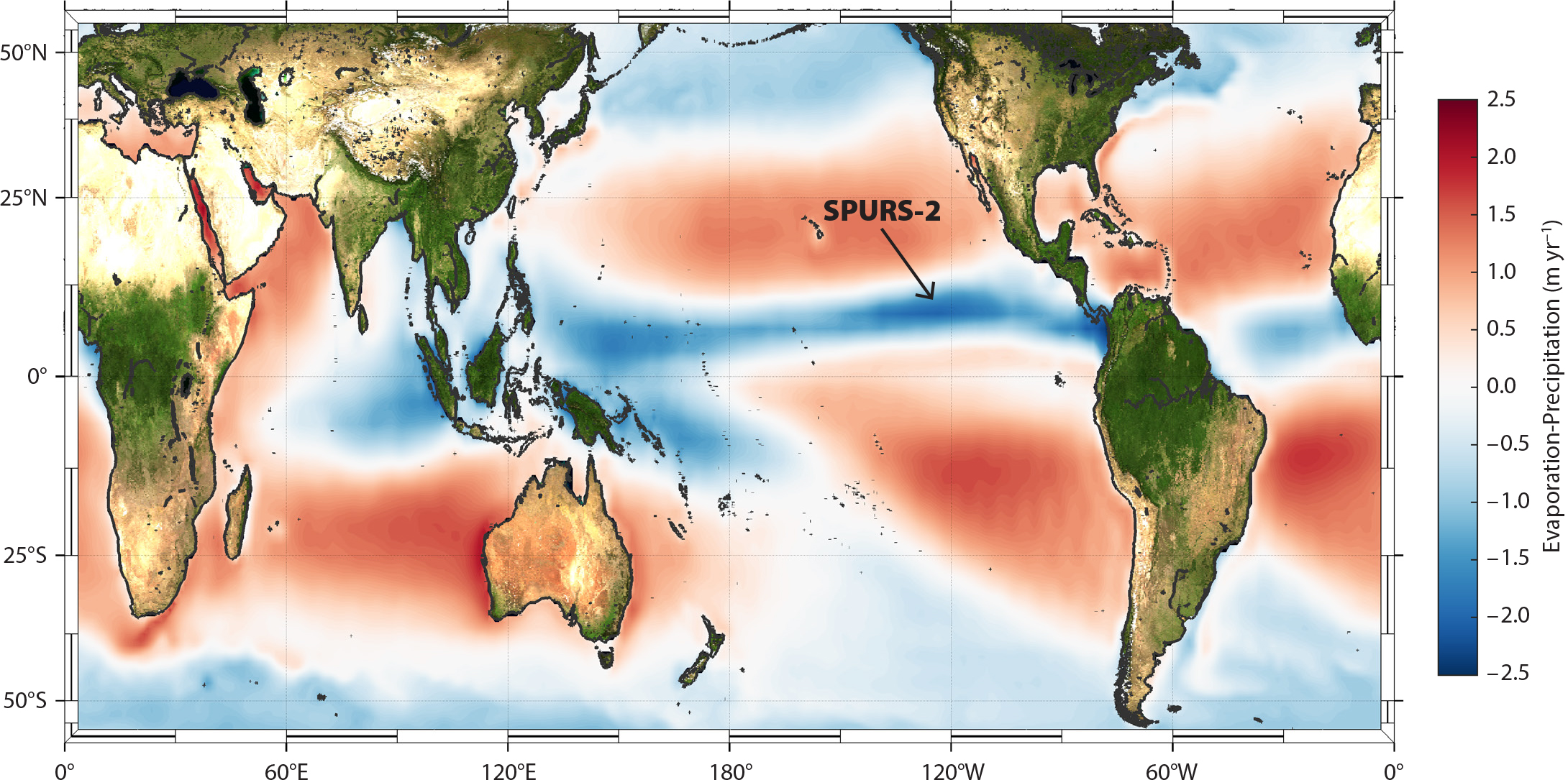Full Text
|
|
In this special issue of Oceanography we explore the results of SPURS-2, the second Salinity Processes in the Upper-ocean Regional Study (SPURS), conducted in the eastern equatorial Pacific. SPURS is an ambitious multiyear field program to study surface salinity in evaporation-dominated (SPURS-1) and precipitation-dominated (SPURS-2) regions of the global ocean. The primary goal was to further our understanding of the global oceanic freshwater cycle through investigation of the physical processes controlling the upper-ocean salinity balance: air-sea interactions, transport, and mixing. With the advent of satellites capable of measuring sea surface salinity, such as NASA’s Aquarius instrument and the Soil Moisture Active Passive (SMAP) satellite, as well as the European Space Agency’s Soil Moisture and Ocean Salinity (SMOS) platform, a near-synoptic view of such processes has become possible (Figure 1). To take full advantage of such observations, we need to understand the link between upper-ocean dynamics and the oceanic freshwater cycle.
|
|
Evaporation and precipitation are the two main components of the global water cycle. The ocean covers over 70% of Earth’s surface and accounts for approximately 86% of global evaporation and 78% of global precipitation (Schanze et al., 2010). In comparison, only 10% of moisture is transported to land and returned via river runoff (Trenberth et al., 2007). Evaporation removes freshwater from the ocean’s surface, leaving saltier water near the surface, while precipitation and river runoff freshen the surface ocean and lower sea surface salinity. The global patterns of evaporation and precipitation are distinctly different. Evaporation is maximum over the tropical warm pool regions and along the paths of western boundary currents due to increased air-sea temperature contrast in these areas. Conversely, precipitation tends to be greater in high latitudes and beneath the Intertropical Convergence Zone (ITCZ), where the northerly and southerly trade winds meet. Combined, evaporation and precipitation create the complex and variable global patterns of ocean freshwater flux (Figure 2).
|
|
Evaporation and precipitation vary on smaller scales as well. Evaporation is a relatively slowly varying process, governed by wind speed and air-sea humidity and temperature differences. In contrast, precipitation is a more episodic and patchier phenomenon that can lead to rapid surface freshening. The fate of freshwater delivered to or extracted from the ocean’s surface is determined by both advective transport and mixing within the coupled ocean-atmosphere boundary layers. It is the combination of these processes that set the global patterns of sea surface salinity (Figure 1).
The overall SPURS program comprised two distinct field experiments because, as author and NASA program manager Eric Lindstrom put it, “SPURS always come in pairs.” The first half of the pair, SPURS-1, investigated processes within the subtropical North Atlantic salinity maximum (Lindstrom et al., 2015), centered around 24.5°N, 38°W. This region of the North Atlantic has been described as an oceanic desert, where evaporation exceeds precipitation because dry air from the Sahara and Sahel regions absorbs water vapor as it travels westward (Figure 2). The ocean’s salinity maximum regions export moisture to the precipitation-dominated regions of the tropics and high latitudes (Farrar et al., 2015). While this export to these two areas is roughly equally partitioned, the resulting precipitation tends to be more intense and episodic in the tropics and more persistent and widespread in high latitudes. The subtropical salinity maximum is generally considered a quiescent region with low ocean dynamics. Three cruises between 2012 and 2013 as well as dozens of autonomous assets deployed during those cruises nevertheless revealed a complex advective-diffusive system with sharp surface salinity gradients. The SPURS-1 program also fostered the development of new technologies to observe salinity both at the surface and below.
The second half of the pair, SPURS-2, the focus of this special issue, centered around the precipitation-dominated region beneath the ITCZ in the eastern tropical Pacific. The ITCZ is a meandering band of atmospheric moisture convergence that circles the globe where the northerly and southerly trade winds meet. As noted by Lindstrom et. al (2015), the pair of SPURS field programs are complementary in that the atmospheric moisture provided by evaporation over the salinity maximum is transported by the North Atlantic trade winds across Central America to supply some of the moisture that precipitates out of the ITCZ over the eastern tropical Pacific (see title page image).
The tropical Eastern Pacific Fresh Pool (Alory et al., 2012) forms beneath the ITCZ due to extremely high rainfall rates, which produce some of the lowest surface salinities found in the open ocean. The surface salinity within the fresh pool also exhibits one of the strongest annual cycles within the world ocean (Farrar and Plueddemann). The convective precipitation that falls under the ITCZ lays down patches of freshwater at a wide variety of scales: horizontally, vertically, and spatially (Boutin et al., 2016). The key scientific objective for SPURS-2 is to determine what oceanic processes transform shallow, patchy “puddles” of freshwater into the large-scale mean distribution of salinity that defines the Eastern Pacific Fresh Pool. In other words, “where does the freshwater go” (Farrar et al., 2014)?
The SPURS-2 field program took place in an area centered around 10°N, 125°W (Figure 1) over a span of 16 months, from August 2016 to November 2017. During this period, a set of three surface moorings was deployed along the 125°W meridian (Farrar and Plueddemann) to serve as a focal point of the program’s shipboard and autonomous surveying. Oceanic and atmospheric surveys of the SPURS-2 region were conducted from R/V Revelle during two three-week periods after deployment and before recovery of the moorings. The science teams participating in SPURS-2 deployed a remarkable set of platforms and instrumentation to investigate the fate of freshwater entering the SPURS-2 domain (Lindstrom et al., 2017). In addition to the surface moorings, these platforms included the highly instrumented R/V Revelle and schooner Lady Amber (Asher et al., Clayson et al., Rainville et al.), towed sensor platforms (Drushka et al., Sprintall), surface drifters (Volkov et al.), profiling floats (Riser et al., Shcherbina et al.), Seagliders, Wave Gliders, autonomous sailing vehicles (Zhang et al.), ship-based radars (Rutledge et al., Thompson et al.), and GPS rawinsondes (Clayson et al.).The observations made from these platforms span vertically from the atmospheric stratosphere through the ocean mixed layer down to a depth of 2,000 m, and they were horizontally distributed throughout the SPURS-2 domain.
One of the objectives of both SPURS field programs was to investigate the mechanisms that drive the patterns of upper-ocean salinity variability. Measurements from satellites, ship transects, precipitation radars, drifters, profilers, Lagrangian floats, towed systems, and autonomous vehicles are being used to quantify the horizontal variability from tens of centimeters to hundreds of kilometers. The larger-scale patterns of salinity variations beneath the ITCZ are clearly evident in satellite remote sensing of sea surface salinity provided by Melnichenko et al. Their findings from NASA’s Aquarius and SMAP salinity missions depict the SPURS-2 region as a highly dynamic area with strong seasonal, intraseasonal, and interannual variability. At higher resolution, the specialized ship-based C-band radar described by Rutledge et al. and modifications to the ship’s X-band marine radar described by Thompson et al. are being used to investigate the small-scale precipitation structure. The dual polarimetric C-band radar provides high resolution maps of accumulated rainfall extending out to 125 km from the ship at five-minute intervals. The rain maps generated by the X-band radar resolve scales of 0.03 km every minute to provide high-resolution views of rain and rain variability within 30 km of the ship.
The air-sea interaction team, with help from many cruise participants, launched approximately 80 rawinsondes during each of the two R/V Revelle cruises to further characterize the atmospheric boundary layer. Clayson et al. use the soundings from eight north-south transects to investigate the atmospheric moisture budget over the SPURS-2 region. With these observations, the moisture budget closes within the observational uncertainty. The observed patterns of moisture flux convergence and divergence agree qualitatively with satellite-derived evaporation, precipitation, and sea surface salinity features. Clayson et al. also describe the direct covariance flux systems that were paired with infrared hygrometers to directly measure the moisture flux at the surface mooring and at R/V Revelle’s locations. These measurements are being used to improve the Coupled Ocean-Atmosphere Response Experiment (COARE) bulk flux algorithm and its estimation of evaporation.
Several in situ studies also address the issue of salinity variability during SPURS-2. Farrar and Plueddemann report on the upper-ocean dynamics of the tropical Eastern Pacific Fresh Pool using yearlong observations from the SPURS-2 central mooring. The mooring data provide the surface fluxes and vertical oceanic profiles required by the surface-layer salinity budget. Their preliminary investigation uses sea surface salinity (SSS) measurements from the SMAP satellite to estimate the horizontal gradients in the vertically averaged salinity within the surface layer, assuming that the vertical gradient of salinity in the surface layer is small. The mooring results indicate that this is a good approximation for weekly and longer timescales. In addition to heavy rainfall, preliminary results reveal the importance of seasonal variability of large-scale currents in controlling the transition between the “salty” and “fresh” seasons. The study by Farrar and Plueddemann also finds a near balance between the surface flux and mixing across the base of the mixed layer. As a result, they show that at the SPURS-2 site, horizontal advection accounts for most of the variability in surface salinity on monthly to seasonal timescales.
Riser et al. describe broad-scale observations of wind, rain, and water-mass structure provided by a fleet of 15 Argo profiling floats that collect temperature/salinity profiles down to 2,000 m, with a focus on the upper few hundred meters. Several of the floats were specially equipped with Passive Aquatic Listener (PAL) units to estimate wind speed and rainfall using passive acoustic techniques. These profilers show large-scale meridional and zonal seasonal variability in wind, rain, currents, and water-mass structure, with significant variability along the ITCZ. A sidebar by Sprintall presents a complementary view of the peculiar vertical thermohaline structure found in the SPURS-2 region during the two cruises. This view was provided by 50 traditional CTD casts and a towed (underway) CTD system that logged over 750 underway temperature/salinity profiles.
Rainville et al. chronicle the use of a small specially equipped sailing vessel, Lady Amber, in lieu of traditional research vessels. Lady Amber deployed a number of mobile assets used in SPURS-2, including Lagrangian floats and surface drifters launched between the field campaigns aboard R/V Revelle. Several of the science teams instrumented Lady Amber with atmospheric and oceanographic sensors to collect data during deployment activities. While many of these measurements were made as proof-of-concept on such a vessel, a number of the results described by Rainville et al. are proving useful for SPURS-2 participants. Additional innovative platforms used the high-quality measurements to validate their own measurements. For example, Zhang et al. describe the use of saildrones, unmanned surface vehicles that are capable of extended missions and equipped with a variety of sensors whose measurements are compared here to shipboard and moored observations during SPURS-2.
A number of SPURS-2 research groups investigated the role precipitation plays in the salinity, temperature, and resulting density structure of the upper ocean at higher spatial and temporal resolution. Volkov et al. describe a long-term study of near-surface stratification using six surface drifters equipped with two pairs of temperature and salinity sensors (Dong et al., 2017) at 0.4 m and 5 m. The time series from these sensors characterize stratification caused by both temperature and salinity due to diurnal warming and rainfall, respectively. Their results suggest that the weekly averaged satellite estimates of SSS can provide accurate estimates of horizontal gradients in the vertically averaged salinity as assumed by Farrar and Plueddemann. As in previous studies, Volkov et al. find that rain-induced surface freshening and diurnal warming that result from insolation are strongly dependent on wind speed: their measurements show that near-surface salinity and temperature gradients are absent at wind speeds greater than 7 m s–1. At lower wind speeds, temperature measurements at depths of both 0.4 m and 5 m and the near-surface salinity measurement at 0.4 m exhibit wind-modulated diurnal cycles. Their drifter data show that such stratification can persist for up to 24 hours, which is substantially longer than previous estimates.
Clayson et al., Drushka et al., and Shcherbina et al. investigate stratification of the upper ocean due to precipitation and insolation and how it acts as a barrier to wind-induced mixing. Clayson et al. combine observations from the central mooring with the Kantha and Clayson (1994) mixed layer model to investigate the relative importance of temperature and salinity stratification in turbulence and mixing in the upper ocean. In general, the model simulations show that individual rain events can briefly inhibit mixing very near the ocean surface before being overwhelmed by wind-driven turbulence. However, simulations run with and without rain clearly show that the cumulative effect of multiple rain events is a comparatively shallower mixed layer (compared to the no-rain simulation) due to additional stabilization of the upper ocean by freshening. Ongoing studies are using cloud-resolving large eddy simulations (LES) with the mixed layer model to investigate the coupled response of the oceanic mixed layer. Shcherbina et al. focus on autonomous observations of the interplay between upper-ocean wind-driven shear and thermohaline stratification. They show that stratification was routinely present in the upper meters of the water column—whether due to rain, surface heating, or both. The strongly stratified near-surface layers were rapidly accelerated by wind, producing the well-known “slippery layer” effect and thereby potentially enhancing oceanic feedback to atmospheric forcing. Numerical LES are shown to produce adequate representation of the evolution of an upper-ocean boundary layer, thus providing context for interpretation of the observations. The study highlights the need for further development and refinement of high-quality autonomous measurements of surface heat fluxes, wind stress, and precipitation in conjunction with underwater sampling of ocean responses.
Drushka et al. describe detailed observations of the structure and evolution of surface fresh layers with a towed platform known as the surface salinity profiler (SSP). The SSP is rigged to be towed off the side of the research vessel, thus placing the platform and its sensors outside the ship’s wake to sample undisturbed water. The SSP sensors measure temperature and salinity at multiple depths between 0.05 m and 1.10 m. Similar to the measurements made by Volkov et al. and the simulations by Clayson et al., the freshening observed by the SSP between these depths is directly proportional to rainfall rate and inversely proportional to wind speed. While the regression coefficients found from fits to the field data are consistent with those found by Drushka et al. (2016), the scatter in the field data suggests that factors other than rainfall rate and wind forcing have significant impacts on the salinity profile. For example, Drushka et al. observed that the individual freshening events captured by the SSP appear to be affected by horizontal advection, increased mixing by surface waves, and stratification from previous diurnal warm layers and/or rain events. Asher et al. investigate the rates of near-surface “skin layer” renewal by observing the cooling rate of warm spots created on the water surface with an infrared laser. The results suggest higher rates of surface mixing in the presence of rain at low wind speeds.
The SPURS-2 science teams have leveraged numerical simulations and parameterizations to optimize their sampling strategies and to interpret their data. For example, Li et al. use multiscale numerical modeling and data assimilation to provide guidance in support of SPURS-2 experiments. While the field program has ended, much of the work to analyze and compare the gathered data is just starting. The SPURS-2 teams are currently focusing on synthesizing and comparing observations on scales ranging from turbulent dissipation to global patterns of precipitation and salinity. This work includes studies of rainfall variability, the mixed layer, and the oceanic carbon cycle. Moreover, an unprecedented amount of salinity measurements in the uppermost 20 cm of the ocean is fast proving to be a treasure trove for satellite calibration and validation. Bingham et al. provide an overview of the entire SPURS-2 data collection effort, as well as references for all data from individual platforms and sensors gathered during the experiment. We look forward to many more studies that will result from this unique data set.




